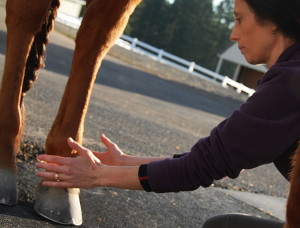Diagnosing and Treating a Common Ailment
by R. Paul Schwab, DVM
 Most horse owners will eventually deal with an abscess in their horse’s hoof. The common scenario is sudden, non-weight bearing lameness in one of the legs. Hoof abscess pain is so severe that many people think that their horse has broken its leg. For veterinarians and farriers this kind of lameness is great because, usually, it is a quick and dramatic fix: open abscess and the horse is better that night. However, this isn’t always the case.
Most horse owners will eventually deal with an abscess in their horse’s hoof. The common scenario is sudden, non-weight bearing lameness in one of the legs. Hoof abscess pain is so severe that many people think that their horse has broken its leg. For veterinarians and farriers this kind of lameness is great because, usually, it is a quick and dramatic fix: open abscess and the horse is better that night. However, this isn’t always the case.
An abscess in the hoof can occur from a couple of scenarios. The first is a puncture. A horse steps on a nail or sharp rock, it punctures through the sole or frog, introduces bacteria in the sensitive, vascular soft tissues and causes an infection. A nail from a shoe can cause an abscess in a similar manner if it was placed too close to the lamina or “quick.”
Abscesses can also occur in horses with poor hoof care and/or poor hoof quality. If the hoof is allowed to grow too long it has more chances of cracking and/or packing manure and mud into crevices and small fissures in the sole and white line. Over time bacteria can work its way into the sensitive tissues starting a local infection that turns into an abscess. The same thing can occur in horses with toe or quarter cracks. Horses that have chronic laminitis tend to get abscesses more easily as well. The junction between the sole and the hoof wall in laminitic horse becomes wider at the bottom of the hoof exposing tiny fissures that are more susceptible to infection.
As stated before, horses with an abscess are usually quite lame, usually in one foot. Heel abscesses in hind feet are sometimes not as noticeable (they don’t bear as much weight on the hind limbs). There may be heat in the hoof, especially near the abscess itself. A strong digital pulse can be felt over the arteries that pass over the back of the fetlock. Sometimes there may be swelling at and slightly above the fetlock, especially if the horse has been lame a few days, or if the abscess is quite severe. If you clean the bottom of the foot you may see the puncture or entry point of the abscess, but most of the time it is difficult to find where the abscess started. Your veterinarian or farrier will usually use a foot tester to put pressure over various sections of the sole to find where it is most painful. Sometimes all it takes is thumb pressure. Once the painful area is located, that region of the hoof is explored with a hoof knife until the abscess is found and drained. The hoof may be soaked in an Epsom salt solution and then wrapped to protect the bottom of the foot until it heals.
If the abscess isn’t opened at the bottom of the foot it will eventually work its way up and break out of the coronary band. The horse will feel better, but will have much more damaged tissue to heal and grow out. Abscesses that break out of the back of the hoof will often slough off much of their frog.
It is important to look into your horse’s tetanus vaccination status. Hoof abscesses are an excellent entry point for tetanus infection. If it has been more than 6 months since vaccination, the horse should get a booster. Also, some horses with hoof abscesses, especially those from puncture wounds, may need antibiotics as well as anti-inflammatories like Bute or Flunixin (Banamine).
Most hoof abscesses do quite well once drained. Those that don’t respond may need a larger hole for drainage, have a foreign body in the foot, or a fracture of the coffin bone. Deep punctures, especially those from nails, can penetrate into the flexor tendons within the foot or into the navicular joint. These type of injuries can be life threatening. We often recommended taking an x-ray of the foot before removing a nail to see if the nail has entered these vital structures.
Call your veterinarian or farrier if you think your horse has a hoof abscess. Early intervention can reduce pain for the horse as well as get him or her back to work sooner.
Published February 2012 Issue

The Northwest Horse Source is an independently owned and operated print and online magazine for horse owners and enthusiasts of all breeds and disciplines in the Pacific Northwest. Our contemporary editorial columns are predominantly written by experts in the region, covering the care, training, keeping and enjoyment of horses, with an eye to the specific concerns in our region.






